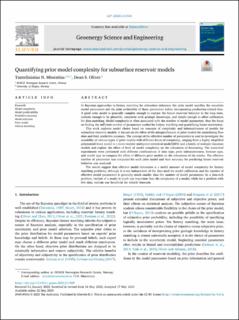| dc.contributor.author | Mioratina, Nomenjanahary Tanteliniaina | |
| dc.contributor.author | Oliver, Dean | |
| dc.date.accessioned | 2024-01-30T08:30:44Z | |
| dc.date.available | 2024-01-30T08:30:44Z | |
| dc.date.created | 2023-05-23T12:12:49Z | |
| dc.date.issued | 2023 | |
| dc.identifier.citation | Geoenergy Science and Engineering. 2023, 227 . | en_US |
| dc.identifier.issn | 2949-8929 | |
| dc.identifier.uri | https://hdl.handle.net/11250/3114422 | |
| dc.description.abstract | In Bayesian approaches to history matching for subsurface inference, the prior model specifies the uncertain model parameters and the joint probability of those parameters before incorporating production-related data. A good prior model is generally complex enough to capture the future reservoir behavior in the long term, realistic enough to be plausible, consistent with geologic knowledge, and simple enough to allow calibration for data matching. Model complexity is often associated with the number of model parameters, thus the focus on finding the sufficient number of parameters needed for history matching and quantifying future uncertainty. This work explores model choice based on concepts of complexity and informativeness of models for subsurface reservoir models. It focuses on the effect of the misspecification of prior models for assimilating flow data and their predictive accuracy. The concept of the effective number of parameters is used to investigate the suitability of various types of prior models with different levels of complexity, ranging from a highly simplified polynomial trend model to a more realistic multipoint statistical model(MPS) and a family of isotropic Gaussian models and explore the effect of level of model complexity on the robustness of forecasting. The numerical experiments were performed with different combinations of data type, prior informativeness, forecast type, and model type to compare the effect of different prior models on the robustness of the results. The effective number of parameters was computed for each prior model and their accuracy for predicting future reservoir behavior was analyzed. The results suggest that effective model dimension is a useful measure of model complexity for history matching problems, although it is not independent of the data used for model calibration and the number of effective model parameters is generally much smaller than the number of model parameters. In a data-rich problem, realism of a model is much less important than the complexity of a model, while for a problem with few data, realism was beneficial for reliable forecasts. | en_US |
| dc.language.iso | eng | en_US |
| dc.rights | Navngivelse 4.0 Internasjonal | * |
| dc.rights.uri | http://creativecommons.org/licenses/by/4.0/deed.no | * |
| dc.title | Quantifying prior model complexity for subsurface reservoir models | en_US |
| dc.title.alternative | Quantifying prior model complexity for subsurface reservoir models | en_US |
| dc.type | Peer reviewed | en_US |
| dc.type | Journal article | en_US |
| dc.rights.holder | © 2023 The Author(s) | en_US |
| dc.description.version | publishedVersion | en_US |
| cristin.ispublished | true | |
| cristin.fulltext | original | |
| cristin.qualitycode | 2 | |
| dc.identifier.doi | 10.1016/j.geoen.2023.211929 | |
| dc.identifier.cristin | 2148695 | |
| dc.source.journal | Geoenergy Science and Engineering | en_US |
| dc.source.volume | 227 | en_US |
| dc.source.pagenumber | 15 | en_US |
| dc.relation.project | Norges forskningsråd: 295002 | en_US |

